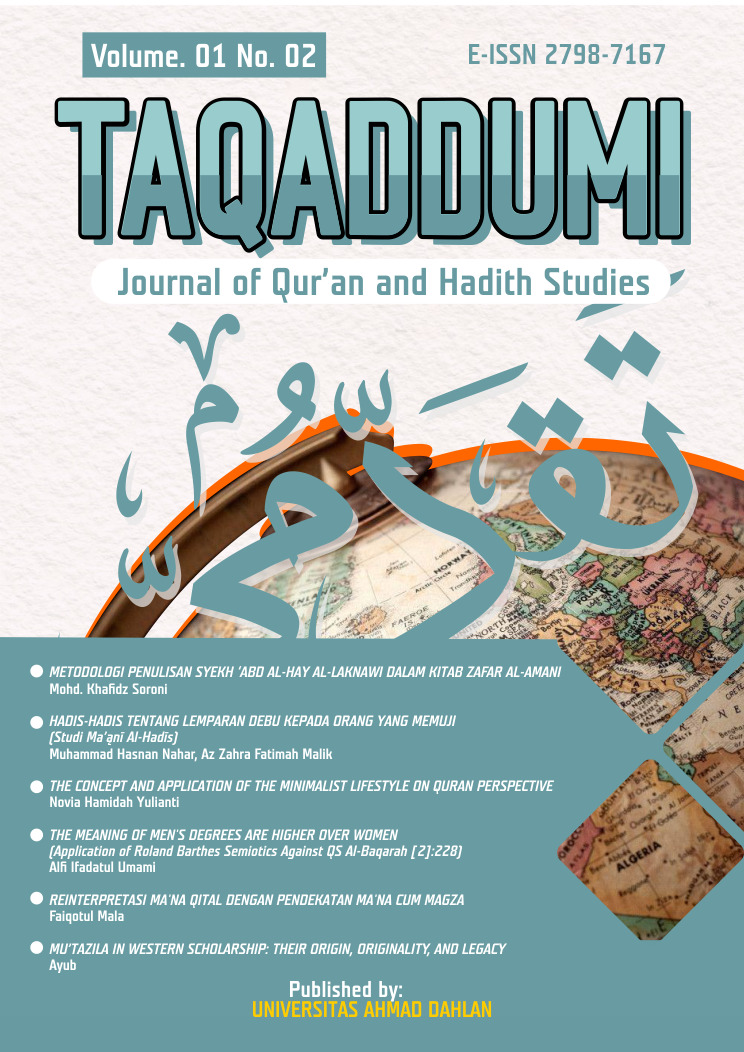THE CONCEPT AND APPLICATION OF THE MINIMALIST LIFESTYLE ON QURAN PERSPECTIVE
DOI:
https://doi.org/10.12928/taqaddumi.v1i2.4559Keywords:
Minimalist lifestyle, minimalist lifestyle concept, application of a minimalist lifestyleAbstract
Lifestyle is a natural thing, not triggered by certain things such as advertisements, living environment, and so on. As is known, meeting the needs is already important, but if it exceeds the limit, it means that it cannot be said to be normal or reasonable. Lifestyle is a pattern of action that distinguishes one person or group from another. If the lifestyle is as an ideology, it will form an identity that is individual or group and distinguishes it from others. Lifestyle has a goal to then be able to form an image that is proud of both users and participants. The image displayed through a lifestyle is more often in contact with a person's various appearances and has properties that can be captured and felt by the senses. The image that arises on the lifestyle chosen by a person is closely related to values and social status. The concept of a minimalist lifestyle is in harmony with Islamic values. In the Qur'an itself the concept of minimalist living has been explained in several suras. The concept of minimalist living is also exemplified by the Prophet and his family. The concept of a lifestyle that teaches behavior not to overdo it in life, whether it's about eating, shopping, or dressing. The concept of minimalist living also teaches you to prioritize what is more needed in life, using what is around you as efficiently as possible. Reducing the number of items or collections owned is included in the concept of minimalist living. Appreciating and caring for what you currently have is also part of the minimalist living concept. In Surah Al-A'raf verse 31, it is explained that you must wear clothes and choose food or drinks within reasonable limits, not excessive. Then in Surah Al-Isra 'verse 26 it is explained that there is a prohibition on wasting the property owned. Then in the same sura, verse 27, it is explained that waste is a reflection of the devil's brothers.
References
“A Brief Hsitory of Minimalism: How The Minimalismt Movement Happened”diakses dari https://minimalism.co/articles/history-of-minimalism, diakses pada 07 Juli 2021 pukul 08.15.
Chayka, Kyle. “The Oppresive Gospel of ‘Minimalism”. The New York Times, diakses dari https://www.nytimes.com/2016/07/31/magazine/the-oppressive-gospel-of-minimalism.html. diakses pada 07 Juli 2021 pukul 08.00.
Firmansyah, M. Anang. 2018. Perilaku Konsumen (Sikap dan Pemasaran). Yogyakarta. Deepublish.
Garitty, Amanda, “What Is The Konmari Method? Here’s How to Declutter The Marie Kondo Way” diakses dari https://www.goodhousekeeping.com/home/organizing/a25846191/what-is-the-konmari-method/, pada tanggal 07 Juli 2021 pukul 17.26.
Kusuma, Ade Chandra Gita. “Filosofi Minimalis, Mengapa Penting untuk Milenial?”. diakses dari https://satupersen.net/blog/filosofi-minimalism-mengapa-penting-untuk-milenial, pada tanggal 07 Juli 2021 pukul 18.35.
Morais, Ines. “The Origin Minimalism” diakses dari https://minimalistroad.com/origin-of-minimalism/, diakses pada tanggal 07 Juli pukul 17.00.
Pratiwi, Yunia. “Sudah Coba Gaya Hidup Minimalis? Ini 9 Manfaatnya untuk Mental” diakses dari https://cantik.tempo.co/read/1351375/sudah-coba-gaya-hidup-minimalis-ini-9-manfaatnya-untuk-mental, pada tanggal 07 Juli 2021 pukul 19.00.
Subagyo, Ridwan Arma. Gaya Hidup Minimalis (Sebuah Tandingan Terhasap Gaya Hidup konsumerisme). Vol.6. 2020.
Zuhaili, Wahbah. Tafsir Al-Munir fi> al-‘aqidah wa asy-syari’ah wa al-manhaj, 2009, Damaskus, Jilid 8 hlm 56.
Downloads
Published
Issue
Section
License
Copyright (c) 2021 Novia Hamidah Yulianti

This work is licensed under a Creative Commons Attribution-ShareAlike 4.0 International License.
License and Copyright Agreement
In submitting the manuscript to the journal, the authors certify that:
- They are authorized by their co-authors to enter into these arrangements.
- The work described has not been formally published before, except in the form of an abstract or as part of a published lecture, review, thesis, or overlay journal. Please also carefully read the Taqaddumi Author Guidelines at http://journal2.uad.ac.id/index.php/taqaddumi/about/submissions#onlineSubmissions
- That it is not under consideration for publication elsewhere,
- That its publication has been approved by all the author(s) and by the responsible authorities – tacitly or explicitly – of the institutes where the work has been carried out.
- They secure the right to reproduce any material that has already been published or copyrighted elsewhere.
- They agree to the following license and copyright agreement.
Copyright
Authors who publish with the Taqaddumi Journal agree to the following terms:
- Authors retain copyright and grant the journal right of first publication with the work simultaneously licensed under a Creative Commons Attribution License (CC BY-SA 4.0) that allows others to share the work with an acknowledgment of the work's authorship and initial publication in this journal.
- Authors are able to enter into separate, additional contractual arrangements for the non-exclusive distribution of the journal's published version of the work (e.g., post it to an institutional repository or publish it in a book), with an acknowledgment of its initial publication in this journal.
- Authors are permitted and encouraged to post their work online (e.g., in institutional repositories or on their website) prior to and during the submission process, as it can lead to productive exchanges, as well as earlier and greater citation of published work.









